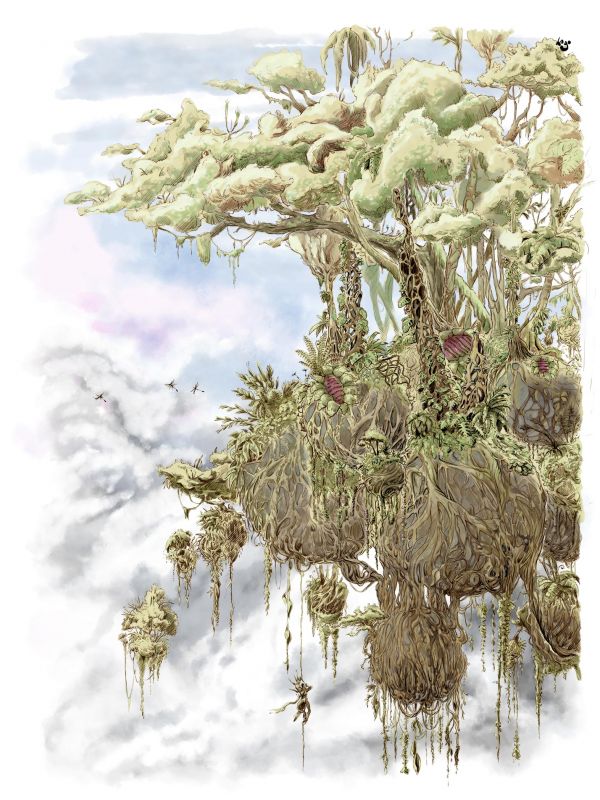Difference between revisions of "Air plants"
ScruffyHugo (talk | contribs) |
ScruffyHugo (talk | contribs) |
||
| (5 intermediate revisions by the same user not shown) | |||
| Line 1: | Line 1: | ||
| − | + | [[File:2021_04_10_airPlantA_master2k.jpg|thumb|600px|border|right|An Air Forest observed in the valleys of eastern Lume, the parachute seeds employing wind currents for wider dispersal. A [[Dunefolk]] scales the vines in a risky gambit for rare ingredients. ]] | |
| − | + | ==''Tillandsia aeranthos''== | |
| + | Hovering anywhere from a few [[spans]] to hundreds of [[paces]] above the ground, these incredible Floating Forests pepper the skyline, filling the skies with life. Born of the genetic manipulation typical of the ancient Deumana, these majestic, elevated gardens have flourished in the skies of Lume unopposed, far outliving their proud landscapers. The plants are anchored to immense, floating gourds, each tight with internal gases; the source of their air-borne particularity. There are regions of the Continent where fields of interlocking orbs stretch to the horizon. | ||
| − | + | Seasonally, these volar flora emit a pollen-rich effluvium that travels on the breeze. The resulting seeds drop to the soil below, where the infant plants grow rotund on nutrients before taking to the skies, briefly tethered on root-like vines that eventually sever. | |
| − | + | The gourds may also release an irritant pollen that serves as self-defense against herbivory, spraying any opportunists looking to harvest them. When the sensitive roots that encompass the gourds are disturbed, the transgressor is doused with an aerosol effective enough to rebuke the hardiest of creatures. Ill-effects such as sneezing, nausea, severe itching, temporary blindness, and difficulty breathing, have all been documented by Folk healers. Though these symptoms are not typically fatal, wheezing and stumbling around blind at such heights is certainly a formula for a brief, if exciting, life. | |
| − | + | The cleverest of [[Lands of Lume|Lume's]] aerial creatures have evolved specialised methods to safely benefit from these forests; not only for nourishment, but as shelter from predators, and invaluable sanctuaries during breeding cycles. Additionally, some [[Folk]] cultures have developed alongside the large air plants, even re-purposing the gourds for limited flight. The children of these communities grow nimble and confident playing among the orbs, swinging deftly between the orbs. Feats of daring among these [[Folk]] are spoken of by charmed travelers. | |
| + | |||
| + | |||
| + | |||
| + | '''''If an air tree falls, what sound does it make?''''' | ||
Latest revision as of 11:37, 9 September 2022

Tillandsia aeranthos
Hovering anywhere from a few spans to hundreds of paces above the ground, these incredible Floating Forests pepper the skyline, filling the skies with life. Born of the genetic manipulation typical of the ancient Deumana, these majestic, elevated gardens have flourished in the skies of Lume unopposed, far outliving their proud landscapers. The plants are anchored to immense, floating gourds, each tight with internal gases; the source of their air-borne particularity. There are regions of the Continent where fields of interlocking orbs stretch to the horizon.
Seasonally, these volar flora emit a pollen-rich effluvium that travels on the breeze. The resulting seeds drop to the soil below, where the infant plants grow rotund on nutrients before taking to the skies, briefly tethered on root-like vines that eventually sever.
The gourds may also release an irritant pollen that serves as self-defense against herbivory, spraying any opportunists looking to harvest them. When the sensitive roots that encompass the gourds are disturbed, the transgressor is doused with an aerosol effective enough to rebuke the hardiest of creatures. Ill-effects such as sneezing, nausea, severe itching, temporary blindness, and difficulty breathing, have all been documented by Folk healers. Though these symptoms are not typically fatal, wheezing and stumbling around blind at such heights is certainly a formula for a brief, if exciting, life.
The cleverest of Lume's aerial creatures have evolved specialised methods to safely benefit from these forests; not only for nourishment, but as shelter from predators, and invaluable sanctuaries during breeding cycles. Additionally, some Folk cultures have developed alongside the large air plants, even re-purposing the gourds for limited flight. The children of these communities grow nimble and confident playing among the orbs, swinging deftly between the orbs. Feats of daring among these Folk are spoken of by charmed travelers.
If an air tree falls, what sound does it make?
